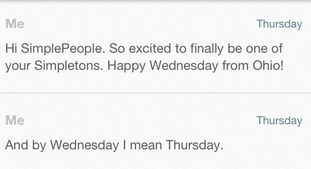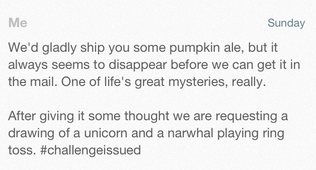 A few years ago, I wrote a piece about the future of marketing. Within the post, I made a few predictions:
A few years ago, I wrote a piece about the future of marketing. Within the post, I made a few predictions:
- We would see people begin to reach a point of marketing max saturation; leading consumers to become more selective about which brands they engage with.
- Brands that showed their “humanness” would rise to the surface and be welcomed into consumer hearts, homes and wallets.
- Consumers would look to do business with brands that treat them like friends and family.
- We would see brands shift from a “ME” mentality to a “WE” mentality.
It’s that fourth point I want to talk about today.
Google the phrase “humanize your brand” and you’ll find roughly 1,000,000 results aimed at helping you accomplish just that. “Humanizing” business has become an industry buzz phrase, an ambiguous mecca and an admirable business goal all rolled into one. Marketers have seen the (profitable) light. The days when “Mad Men” advertising was enough are behind us, and people not only want, but demand, a more personal level of connection with the brands they support. A dollar is a declaration, and consumers want to feel like they’re part of something more than a transaction.
The response? All hail social media! Brands and marketers took to Facebook, Twitter, Pinterest and Instagram on a mission to make things personal. Marketing shifted to a state of “WE” – and everyone was invited. Curiously, the host of the 24-7 party is rarely to be found. Omnipresent, but never presented, the mystery hosts remains cloaked in veil of anonymity. Much like the Great and Powerful Oz, they’re pulling levers, pressing buttons and making magic happen behind-the-scenes. While brands preach about the importance of humanizing their business, many continue hiding what is arguably one of the most important humans on their team: their community manager.
I’ve been mulling this matter of anonymity over in my mind for some time. Opinions within the industry vary greatly, so I decided to turn to a brand that seems to be leading the way when it comes to just about everything: Chipotle.
It’s no secret I’m a fan of the brand. From the way they source ingredients to their social media efforts to that glorious guacamole – they’re doing things right. My reason for asking them to chime in on this topic was simple: of all the brand’s on Twitter, Chipotle is one of the few that goes to great lengths to make sure their customers know their community managers. Every tweet and response is signed with an individual's name. They don’t just strive to humanize the brand, they make sure the humans supporting their brand know the humans behind the wheel (or dashboard, rather) of their social.
Last week Chipotle’s New Media Manager, Joe Stupp, took a few minutes out of his day to chat with me about their viewpoint and strategy.
“Originally, we had a website people could write into. Keep in mind this was at a time when brand websites were relatively new. We would write back, have conversations, really get to know people. We signed everything coming into the website with our name. That was the beginning of a digital extension to our personal approach customer service, and it’s how we still do things today.
As Chipotle started to grow as a company, we felt like we were at risk of losing the local flavor and in-person touch we were able to accomplish when we had one, two, twenty restaurants. We didn’t want to talk to people like a big corporation, we wanted to talk to them like we would face-to-face over a margarita.”
And that they have. Joe mentioned that it’s not unusual for brand fans traveling through Denver to reach out to the social team to ask if they can meet up for lunch at the original Chipotle. (And they often do.)
One of the strongest arguments against giving community managers a name and a face comes down to brand equity. If fans bond with the specific person driving the brand’s social, what does that mean for the brand if/when they decide to move on to a new job?
“We have had people [from our social team] leave. In one instance, customers were asking for a former employee for months after he left. We made up absurd stories about how he was off climbing the Himalayas, and eventually everyone adjusted and moved on. People are going to leave. We don’t worry about that.
I don’t feel that you lose a brand message by humanizing it and giving employees a face or a name. We don’t talk about ourselves at all on the brand handle, so there are no issues with self-promotion. We do it this way because people like to get to know us as humans. We are writing basically 24-7. I think we write more “@” responses than any company out there. When someone is having a problem, it makes a difference if they know that they spoke with Joe-the-human not just an anonymous corporate account. If a customer goes into a restaurant to talk to one of our managers, they can say ‘Joe said I could do it this way.’
Taking anonymity out of the equation facilitates customer service on both ends of the spectrum. We send mass emails with my personal email address on it so that if a customer has a question, they can write me back directly. I will typically get a couple hundred replies. There are fans that have been following us for a long time, and some of them write back every time. Removing the barrier and making our people accessible sends the message that we’re here to talk to them about anything they want to discuss regarding Chipotle.”
Joe offered up a final dose of perspective from the employee side:
“We have fun, but take our job seriously. There’s a greater level of accountability when you strip away the protective layer of anonymity and sign everything you share. If a Chipotle tweet or comment ends up on Buzzfeed or in The New York Times, the whole world is going to know exactly who said it.”
IN CONCLUSION... I believe we’re on the verge of a new era for brands and social media: we by way of me. As brands really dig in and continue to explore what it means to humanize their business and the brand-consumer relationship, their real people must be brought to the forefront. Getting personal requires a person. A community manager is often the first point of contact a customer has with a brand. They wear many hats as a brand reputation manager, a customer service rep and a portal that can transport people from simple transaction to long-tern relationship.
Doing what is less scary for your brand doesn't mean you are doing what is best for your customer. You can’t humanize your brand when you’re hiding your human.











